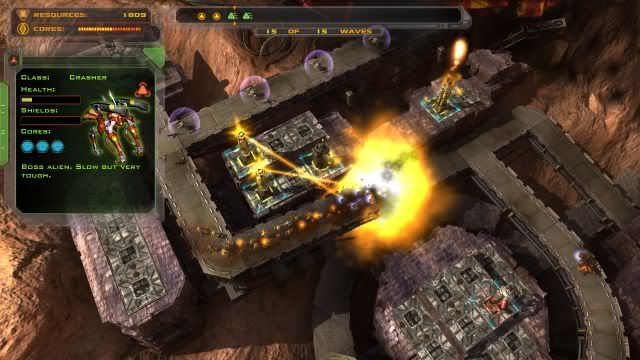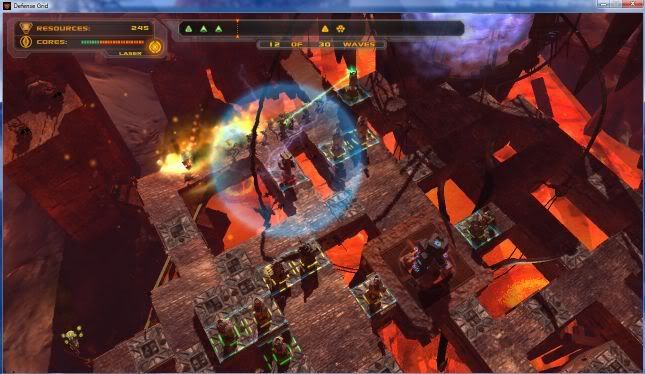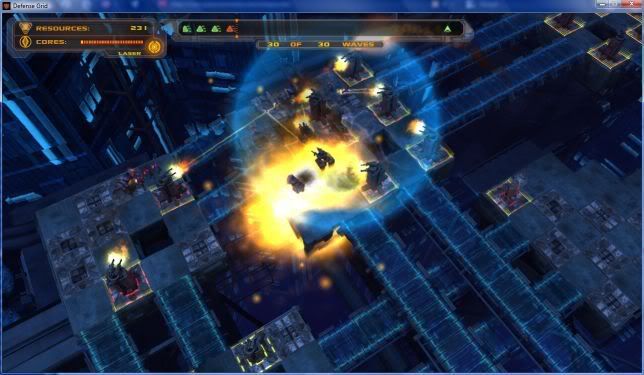Post by Morreion on Jan 24, 2010 9:05:42 GMT -5
Warning! This review is for a non-MMO game 
Lately I've been checking out single-player games on my Steam account. For those of you not familiar with Steam, it is a game portal that allows you to purchase games that are downloadable through one main interface. As a Steam subscriber, I do not need disks for my games, patching my Steam games is easy, and if I get a new PC, I re-download the games I purchased through Steam directly from their interface through my account. Steam offers all different types of games- FPS, RTS, RPG, MMOs. They have occasional sales- for instance, I picked up EQ2, Vanguard and EVE for 5 bucks each. You do not have to have the games downloaded, but at the click of a button, you can DL the most recent version of them at anytime.

One particular game I have been playing lately is called Defense Grid: The Awakening. This is an RTS game (real-time strategy) of the defense tower type, released in 2008. What this means is that you build and upgrade non-movable units that fight for you as you gradually gain resources that are used to purchase new units. Defense Grid is set in the future, and each game map is a set of possible roadways that mobile enemy units of varying types use to gain 'cores', which are power sources for your defense units. Your goal is to defend your cores. The more enemy units you kill, the more defensive towers you can build.

There are 2 major strategies to playing Defense Grid. The first is that both you and the enemy have a variety of units to choose from. For instance, the enemy sends a large variety of robots at your cores. These vary from small fast lightly armored units to large slow-moving heavily armored units. The enemy also has specialized shielded units that require certain types of weaponry to defeat. They also have stealth units that can only be seen by adjacent weapon towers.
Enemy units have no weaponry; they move to collect your cores and then exit the map. Your job is to build immobile towers to stop them from doing this.
You have a variety of towers to build. These include short-range machine-gun-like light guns, medium-range slower heavier cannon, and long-range area-of-affect artillery known as meteors. Specialized towers also exist, such as laser towers which do direct damage with a damage-over-time feature, temporal units that cause enemy robots to slow down, anti-aircraft missile units that can only shoot flying robots, tesla energy units that fire short bursts of heavy energy damage, and command towers that can spot stealthed enemy robots.

The second major feature of the game is that you have a variety of ways to place your defensive towers so that you channel the enemy forces along certain routes. Usually it makes sense to force the enemy to take long roundabout paths towards your cores so that maximum firepower can be brought against them. The more time that the enemy requires to move across the map, the more damage you can pour into them. Block all of those direct routes to your cores! The key here is that enemy units cannot move through your units. You have to leave them a viable path to move (otherwise they will move through your units by default), but you channel them to your maximum advantage.

Not only do you channel the enemy in beneficial ways to defend against them; how you place your variety of units matter. For instance, placing a cannon tower behind a gun tower allows both of these towers maximum effect, because guns can fire point blank at the enemy while cannon cannot- they must have a bit of distance between them and the target. Temporal units that slow the enemy down are great units to cluster masses of gun and tesla towers around; the slower the enemy moves, the more time you have to pour fire into them and kill them.
The campaign has about 20 or so maps. Each map has a different layout and different challenges for you to defend your cores. Sometimes the enemy has only one entrance and exit; occasionally they have 2 or more entrances and exits. You need to shift your unit selection strategy and channeling strategy on every new map you play. The enemy gets harder as the missions build to the big climactic battle. The main computer that you are defending has a voice that gradually reveals a storyline as you play. The maps and units look good, and the weapon effects are fun- solid glowing laser beams, rapid-fire gun flashes, larger cannon flames, blue radar-like pulses of the temporal units, large fiery explosions of the meteor AoE explosions.
You will be defeated, a lot. You hopefully learn from your defeats and try again. The nice thing about replaying a mission is that you can choose to start completely over to change your whole strategy, or you can choose to go back through each succeeding enemy wave of units to simply fine-tune your existing strategy. Enemy units typically come in groups of between 15 and 30 waves, each wave consisting of different varieties of enemy units.

The game gets more challenging as you play. The final mission took me dozens of tries before I finally figured out the strategy to win- it was a great challenge, because the enemy threw 30 waves of units at me in a dizzying variety of capabilities. I finally won the game with literally one core left. It was a nail-biting finish!
I had a great time playing this game and eagerly await a sequel. If you are new to the RTS gaming world, tower defense games are great to start with since you don't have to give movement orders to your forces, which can be complicated. All in all, I definitely recommend this game to anyone interested. I will be restarting it to see if I can beat my previous scores!

Lately I've been checking out single-player games on my Steam account. For those of you not familiar with Steam, it is a game portal that allows you to purchase games that are downloadable through one main interface. As a Steam subscriber, I do not need disks for my games, patching my Steam games is easy, and if I get a new PC, I re-download the games I purchased through Steam directly from their interface through my account. Steam offers all different types of games- FPS, RTS, RPG, MMOs. They have occasional sales- for instance, I picked up EQ2, Vanguard and EVE for 5 bucks each. You do not have to have the games downloaded, but at the click of a button, you can DL the most recent version of them at anytime.

One particular game I have been playing lately is called Defense Grid: The Awakening. This is an RTS game (real-time strategy) of the defense tower type, released in 2008. What this means is that you build and upgrade non-movable units that fight for you as you gradually gain resources that are used to purchase new units. Defense Grid is set in the future, and each game map is a set of possible roadways that mobile enemy units of varying types use to gain 'cores', which are power sources for your defense units. Your goal is to defend your cores. The more enemy units you kill, the more defensive towers you can build.

Laser towers zap robots marching to collect the glowing spherical cores. Defend as many as you can!
There are 2 major strategies to playing Defense Grid. The first is that both you and the enemy have a variety of units to choose from. For instance, the enemy sends a large variety of robots at your cores. These vary from small fast lightly armored units to large slow-moving heavily armored units. The enemy also has specialized shielded units that require certain types of weaponry to defeat. They also have stealth units that can only be seen by adjacent weapon towers.
Enemy units have no weaponry; they move to collect your cores and then exit the map. Your job is to build immobile towers to stop them from doing this.
You have a variety of towers to build. These include short-range machine-gun-like light guns, medium-range slower heavier cannon, and long-range area-of-affect artillery known as meteors. Specialized towers also exist, such as laser towers which do direct damage with a damage-over-time feature, temporal units that cause enemy robots to slow down, anti-aircraft missile units that can only shoot flying robots, tesla energy units that fire short bursts of heavy energy damage, and command towers that can spot stealthed enemy robots.

A meteor tower throws big explosions at groups of robots.
The second major feature of the game is that you have a variety of ways to place your defensive towers so that you channel the enemy forces along certain routes. Usually it makes sense to force the enemy to take long roundabout paths towards your cores so that maximum firepower can be brought against them. The more time that the enemy requires to move across the map, the more damage you can pour into them. Block all of those direct routes to your cores! The key here is that enemy units cannot move through your units. You have to leave them a viable path to move (otherwise they will move through your units by default), but you channel them to your maximum advantage.

That blue pulse is a temporal unit in action, slowing down robots that are nearby.
Not only do you channel the enemy in beneficial ways to defend against them; how you place your variety of units matter. For instance, placing a cannon tower behind a gun tower allows both of these towers maximum effect, because guns can fire point blank at the enemy while cannon cannot- they must have a bit of distance between them and the target. Temporal units that slow the enemy down are great units to cluster masses of gun and tesla towers around; the slower the enemy moves, the more time you have to pour fire into them and kill them.
The campaign has about 20 or so maps. Each map has a different layout and different challenges for you to defend your cores. Sometimes the enemy has only one entrance and exit; occasionally they have 2 or more entrances and exits. You need to shift your unit selection strategy and channeling strategy on every new map you play. The enemy gets harder as the missions build to the big climactic battle. The main computer that you are defending has a voice that gradually reveals a storyline as you play. The maps and units look good, and the weapon effects are fun- solid glowing laser beams, rapid-fire gun flashes, larger cannon flames, blue radar-like pulses of the temporal units, large fiery explosions of the meteor AoE explosions.
You will be defeated, a lot. You hopefully learn from your defeats and try again. The nice thing about replaying a mission is that you can choose to start completely over to change your whole strategy, or you can choose to go back through each succeeding enemy wave of units to simply fine-tune your existing strategy. Enemy units typically come in groups of between 15 and 30 waves, each wave consisting of different varieties of enemy units.

The last mission is very complex and difficult! You have to defend a large area with multiple entrances and exits for your opponents.
The game gets more challenging as you play. The final mission took me dozens of tries before I finally figured out the strategy to win- it was a great challenge, because the enemy threw 30 waves of units at me in a dizzying variety of capabilities. I finally won the game with literally one core left. It was a nail-biting finish!
I had a great time playing this game and eagerly await a sequel. If you are new to the RTS gaming world, tower defense games are great to start with since you don't have to give movement orders to your forces, which can be complicated. All in all, I definitely recommend this game to anyone interested. I will be restarting it to see if I can beat my previous scores!


